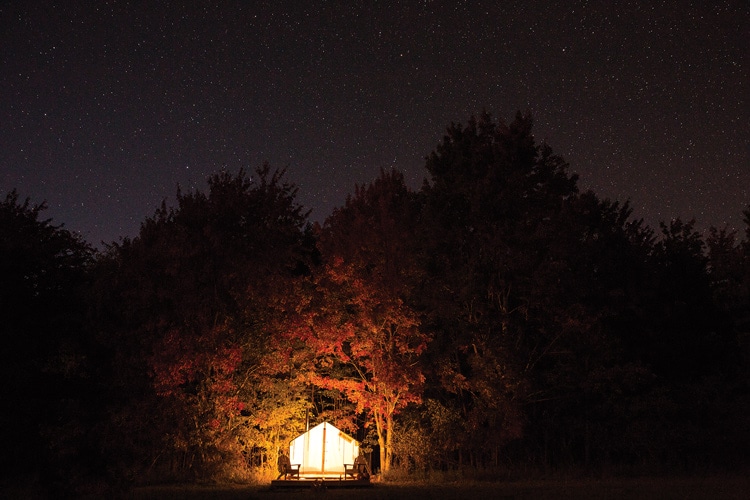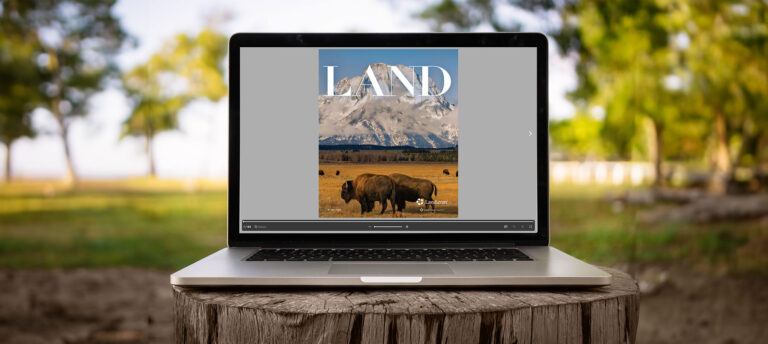The black-and-white photos on the walls of Amy and George Barley’s farmhouse tell the story of their turn-of-the-century homestead, where The Mill Dam Farm once thrived—along with all the other dairy farms—in the charming rural town of Accord, nestled in the heart of the mid-Hudson Valley of New York. One photo dates back to 1913, showing George’s grandfather in a horse-drawn wagon in front of The Barley Mill;
another shows a two-story saw and grist mill that operated until the early 1930s.
When the Barley’s purchased the farmhouse, the only remaining structure on the 52 acres, they envisioned sharing the history of the land—giving “history lessons” and showing off their rare photos. But, like many first-time landowners, it was daunting to think of paying the property tax.
Enter Tentrr, one of a growing number of Airbnb-type online booking platforms and apps for campers to find and instantly reserve spots on private land across the U.S. With state and national parks and forests booking up months in advance, Tentrr, Glamping Hub, Hipcamp, Harvest Hosts, and other online platforms are all on the same mission: to give private landowners an opportunity to share their secluded, unique space with campers and other outdoor lovers.
“A friend came by and said this would be a great Tentrr site,” says Amy, who had seen Tentrr’s catchy hard copy postcards (still distributed by Tentrr).
“Tentrr was everywhere in New York City in 2018!” The postcards delivered a straight-forward message: Are you a landowner? Would you be willing to share your land? Share your land, you earn money.
That year, the Barley’s joined 30 other Tentrr “CampKeepers.” They were especially impressed with Tentrr’s rigorous, personal vetting process, which included meeting with them in the living room of their farmhouse.
“Every single one of our campsites is vetted by a campsite specialist,” explains Tentrr Co-founder and Chief Executive Officer Michael D’Agostino.
First, the specialist has a phone conversation with a landowner about Tentrr’s top criteria: privacy—a minimum of 15 acres in a quiet area; accessibility—parking near campsite.
Then, researchers study videos and Google Maps, according to Tentrr Co-founder and Sales/Development Director Eloise Bune. And, the final step is a walk-through.
“Before we accept a site,” says Bune, “we send a scout with a checklist.”
The Barley’s had the signature Tentrr “wow factor.” What could be better than camping next to your own private waterfall?
“We had the ideal property for this,” says Amy, who grew up visiting the Mill Trail Falls on the Barley’s farm. The timing and location were ideal, too. “The Hudson Valley is booming with wineries and breweries.”
To date, Tentrr has sites in 38 states, including the Pacific Northwest, Southwest and Mountain West. Shhh! The D’Agostino’s own one of the sites. Don’t tell their campers! It’s all about knowing their product, they believe; and, keeping up to date on what works for landowners and what appeals to campers.
“I love being a CampKeeper!” says D’Agostino. “We use our site as a test bed for the whole company—to test new equipment and ideas.”
That’s a must for D’Agostino, since he sat at his drafting table and drew the original design for Tentrr’s “standard kit” or setup. Every site gets a kit for the same price.
“It’s important to us that the payment is the same for every landowner,” says the former investment banker. “We have a lot of landowners who own hundreds of acres and they can divide up their land for several campsites.”
Tentrr charges CampKeepers a one-time fee of $6,500 for a kit that Tentrr staff build and set up on each property, including a canvas expedition tent on a wooden platform, a queen-sized memory-foam mattress with featherbed toppers, wooden crates for storage, two Adirondack chairs, a Brazilian wood picnic table, a stone firepit, a woodburning stove, cookware, sun shower, and a portable toilet. The fee also covers a listing on Tentrr’s app, liability insurance, 24-7 customer support and marketing, and photography.
Today, the Barley’s have two Tentrr setups and a continuous flow of reservations to pay their taxes—and show off their historic land, including remnants of the saw mill’s foundation and pulleys and tracts.
Today’s New and Improved Camping
According to Kampgrounds of America’s 2019 Camping Report, the market for camping is huge and growing, with 62 percent of U.S. households having active campers. Perhaps, more people are camping because they can stargaze on secluded private land, everywhere. But, campers and landowners alike may benefit from brushing up on the sport’s new vocabulary. There’s traditional camping, glamping, gamping, yurting, canopy camping. . . .
KOA recommends sticking to the terms, camping and glamping:
Camping = Tent + Sleeping Bag (including car camping and backpacking)
Glamping = Glamorous + Camping (including cabins, yurts, treehouses, safari tents, teepees, Airstreams, RV’s, etc.)
Whether camping or glamping, people can now camp in state parks, even if they don’t own a tent or sleeping bag. Tentrr and Maine State Parks recently launched The Maine State Park Experience, comprised of sites that are set up and booked through Tentrr.
“We think adding Tentrr will appeal to individuals and families looking for a fun and unique outdoor recreational experiences,” says Melissa Macaluso, Maine Department of Agriculture, Conservation and Forestry, pointing out that all profits go back into supporting state parks.

Simple For Landowners; Simple For Campers
Every day, Ruben Martinez receives emails from landowners telling him of their innovative idea for a camp. The Glamping Hub Co-Founder, who grew up camping in New Mexico, realized that landowners need more than just a booking platform; they need resources to create their camp.
After all, they’re small business owners who are earning a steady income and “getting a business opportunity with extremely low start-up costs,” he says. Who can top that?
A consummate connector, Martinez seized the opportunity to educate landowners and co-founded American Glamping Association in 2018. A fitting concept for Martinez, who proudly reveals that he started Glamping Hub with his best friend so they could talk on the phone daily across the miles.
“It’s an exciting time!” says Martinez. “There is a strong network that allows a high level of access to tools and resources for all business owners.”
Martinez’s leadership has yielded fast results: a trade magazine, Glamping Business USA, and three conferences, known as The Glamping Summit/USA—a gathering and product expo for landowners, booking platform companies, techies, custom tent and furniture makers, outdoor hospitality consultants, and campground owners. There’s more. In 2020, the association will start an accreditation process for glamping business landowners.
“It’s very complex to open a B&B or put up a traditional building,” Martinez explains. Landowners have to pull permits, learn local zoning regulations and restrictions, and building codes. It’s simple to put up a yurt or other camping-like structure.
“If I had a listing on Glamping Hub, I’d put up a yurt!” he jokes. “You can rent it out (through a website platform) for a fraction of start-up costs.”
Creativity + Connecting With Campers = Happy Landowners
Many landowners delight in turning their campsite into a unique, memorable outdoor experience, as well as getting acquainted with campers.
Last summer, Hollis Wayne and her Happy Horse Band entourage on kazoo, rhythm guitar, and drums had a group of bicycle campers singing and dancing to original songs and favorite old cover tunes at her Happy Horse Hotel, west of Austin, Texas. A lot of campers come to the 22-acre Hipcamp “resort” for the live music, according to Wayne, lead singer and owner, who belts out original tunes and plays harmonica in a pavillon that’s amid RV/tent sites, pens, and covered stalls.
Formerly a “horse people only” campground, Wayne and her husband, Beaux Graham opened their land to campers and started listing it on Hipcamp, an online platform that boasts 285,000 sites across America.
Since 2015, Hipcamp has partnered with landowner “hosts” who set their own prices and design (graphics, photos, copywriting) their own online listings. Hosts keep 90 percent of a camper’s payment. Hipcamp’s latest venture is mapping out campsites in the path of “nature-based events,” as yet another way to help hosts attract campers. So far, last summer’s Total Solar Eclipse, butterfly migrations and meteor showers have been a hit.
For Glamping Hub host Julia Kastendiek, improving and sharing her one-acre sandstone mesa outside of Los Angeles has been a dream come true.
We’ve had people from all over the world—Norway, China, the Phillipines, Japan. . .” says Kastendiek, who custom renovated and built Tiny Tiki Retro Hideaway. “They get out of the car and they say ‘wow, thank you,’ and I say, ‘you haven’t even seen everything’”!
“We’ve had people from all over the world—Norway, China, the Phillipines, Japan. . .” says Kastendiek, who custom renovated and built Tiny Tiki Retro Hideaway. “They get out of the car and they say ‘wow, thank you,’ and I say, ‘you haven’t even seen everything’”!
Upon arrival, Kastendiek gives every camper a personal tour of her “highly unusual” resort: A 1954 Spartan Manor, considered more collectible than vintage Airstreams because of their monocoque aircraft construction, a 1963 Office trailer, and gazebo with furniture, curtains and bed covers designed and sewn by Kastendiek.
Bottom line, both landowners and apps need to fuss over campers, says Joel Holland, who recently recruited the mayor of the City of Pontiac, Illinois, known for Illinois Route 66 Hall of Fame and Museum, to personally meet and greet RV’ers with a gift bag.
Helping Landowners Sell Their Products
When Holland bought Harvest Hosts (HH) in 2018, it was an outdated website with a great concept, connecting RV’ers with local businesses. The video technology entrepreneur immediately knew he wanted to create a benefit for private landowners.
The easy part was a built-in membership. “RV’ers are already happy to be traveling,” he explains. “I wanted to make sure RV’ers purchased their [landowner’s] product when they visit.”
Today, HH has 44,000 RV members who pay a $79 yearly membership fee, so they can visit and park for 24 hours in exchange for supporting an HH “host” business located on private land. When an RV’er signs up, they have to agree to a code of conduct to purchase a product grown or produced by the landowner.
Ask Holland who is joining HH, and he jumps into a story about the first host, Heartland Farm, run by the Dominican Sisters of Peace Catholic nuns and volunteers.
“I drove up in my RV and the nuns—all over 80 years old—told me to park wherever I wanted. They gave me a tour. One of the nuns creates alpaca scarves, one makes soaps, one gives massages. . . . I bought scarves and soaps, and got a massage!”
Ever since, Heartland Farm in Pawnee Rock, Kansas, has had an increase in visitors, and they give their HH income back to their nonprofit.
Sharing The Great Outdoors
Whatever app they use, campers and landowners are creating a whole new outdoor experience. One click, and campers are welcome on private land more than ever before.
“We’re sharing our land with people who want to share the great outdoors,” says Barley. And, ensuring that stories of land are preserved, believes the third-generation owner of The Mill Dam Farm.
With a view of the Appalachian Mountains out the front door, and the Catskill Mountains out the back, the Barleys’ stories are a testament to the area’s industrial past. Perhaps, landowner’s stories will spark new campfire stories that begin or end in Barley’s words, “this is where it all happened. . . .”


